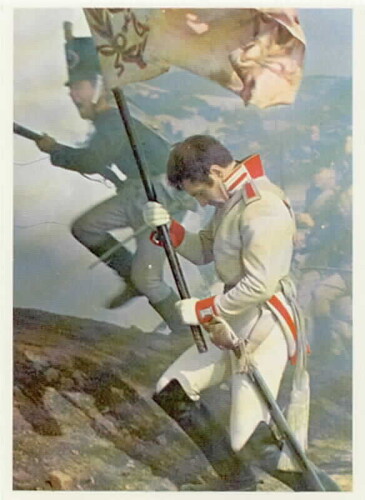
Russian postcard by Sovexportfilm. Publicity still for Voyna i mir/War and Peace (Sergei Bondarchuk, 1965-1966). Caption: "VOINA I MIR, WAR AND PEACE, GUERRE ET PAIX, GUERRA Y PAZ". Collection: Amsterdam EYE Filmmuseum.
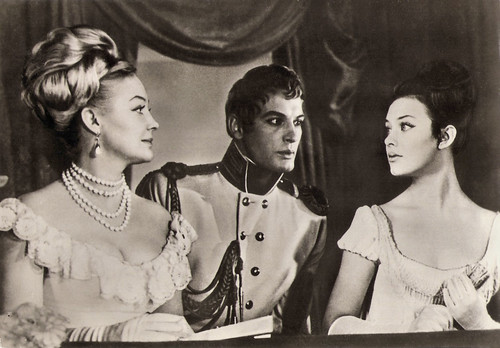
East-German postcard by VEB Progress Filmvertrieb, Berlin no. 2744, 1966. Retail price was 0,20 MDN. Photo: publicity still for Voyna i mir/War and Peace (Sergei Bondarchuk, 1965-1966) with Lyudmila Savelyeva as Natacha Rostova, Irina Skobtseva as Hélène Kuragin, and Vasili Lanovoiy as Anatol Kuragin.
The most expensive film ever made in the Soviet Union
Voyna i mir (Война́ и мир) is a Soviet film adaptation of Leo Tolstoy's novel War and Peace, released in four parts during 1966 and 1967.
Sergei Bondarchuk directed the film series, co-wrote the script and starred in the leading role of Pierre Bezukhov, alongside Vyacheslav Tikhonov and Lyudmila Savelyeva, who depicted Prince Andrei Bolkonsky and Natasha Rostova.
Voyna i mir was produced by the Mosfilm studios between 1961 and 1967, with considerable support from the authorities. At a cost of 8,291,712 Soviet ruble – equal to 9,213,013 U.S. dollar in 1967 rates, or $67 million in 2011, accounting for ruble inflation – it was the most expensive film ever made in the Soviet Union.
Upon its release, it became a success with the audiences, selling approximately 135 million tickets in its native country. Voyna i mir/War and Peace also won the Grand Prix in the Moscow International Film Festival, the Golden Globe Award for Best Foreign Language Film and the Academy Award for Best Foreign Language Film.
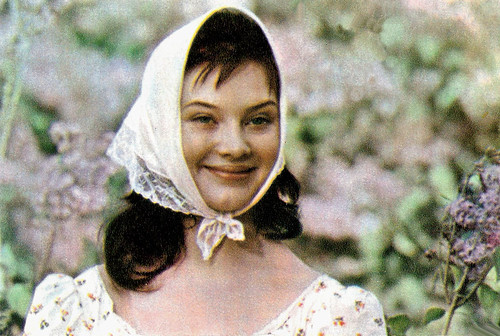
Russian postcard by Izdanije Byuro Propogandy Sovietskogo Kinoiskusstva, no. A 08343, 1969. This postcard was printed in an edition of 500,000 cards. Retail price was 6 kop. Photo: publicity still for Voyna i mir/War and Peace (Sergei Bondarchuk, 1965-1966) with Lyudmila Savelyeva.
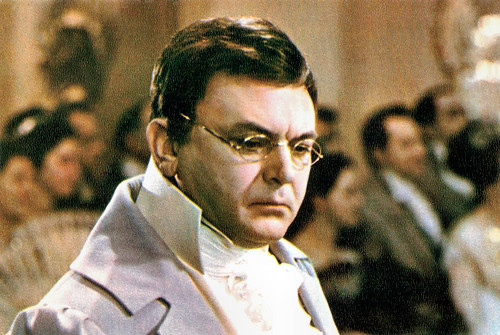
Soviet postcard by Izdanije Byuro Propogandy Sovietskogo Kinoiskusstva, no. A 08341, 1969. This postcard was printed in an edition of 500.000 cards. Retail price: 6 Kop.Photo: publicity still for Voyna i mir/War and Peace (Sergei Bondarchuk, 1965-1966) with Sergei Bondarchuk as Pierre Bezukhov.
A counter strike to King Vidor
The nearing 150th anniversary of the 1812 French Invasion, as well the worldwide success of War and Peace (1959), King Vidor's American-Italian adaptation of the Russian national epic – at a time when the USSR and the United States were struggling for prestige – motivated the Soviet Minister of Culture Yekaterina Furtseva to begin planning a local picture based on Leo Tolstoy's novel.
An open letter which appeared in the Soviet press, signed by many of the country's filmmakers, declared: "it is a matter of honour for the Soviet cinema industry, to produce a picture which will surpass the American-Italian one in its artistic merit and authenticity." According to the German magazine Der Spiegel, the film was to serve as a 'counter strike' to King Vidor.
During 1960, several leading Soviet directors proposed themselves to head the project, but the Ministry of Culture offered it to forty-year-old Sergei Bondarchuk, who had completed his directorial debut, Destiny of a Man, in 1959.
Bondarchuk had not sought out the position and did not know of the proposal until a letter from the Ministry reached him, but he chose to accept it. He represented a generation of young directors promoted by Nikita Khruschev's Kremlin to replace the old filmmakers from the Stalin era.
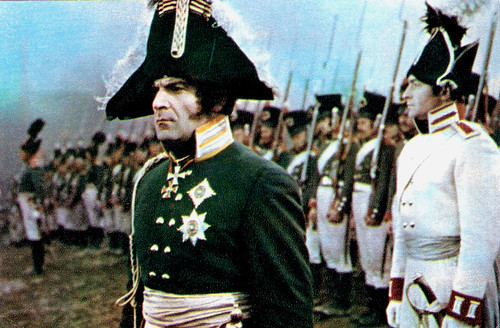
Russian postcard by Izdanije Byuro Propogandy Sovietskogo Kinoiskusstva, no. A 08352, 1969. This postcard was printed in an edition of 500,000 cards. Retail price was 6 kop. Photo: publicity still for Voyna i mir/War and Peace (Sergei Bondarchuk, 1965-1966) with Vyacheslav Tikhonov as Prince Andrei Bolkonsky. Tikhonov is the first from the right, not to be confused with the man in foreground.
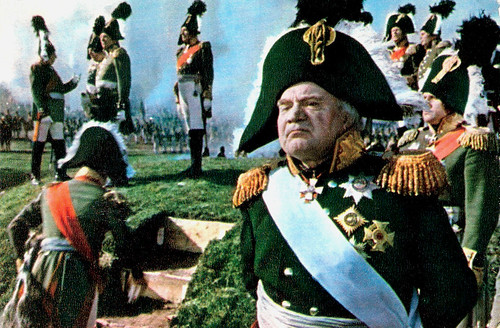
Russian postcard by Izdanije Byuro Propogandy Sovietskogo Kinoiskusstva, no. A 08359, 1969. This postcard was printed in an edition of 500.000 cards. Retail price: 6 Kop. Photo: publicity still for Voyna i mir/War and Peace (Sergei Bondarchuk, 1965-1966) with Boris Zakhava as General Kutuzov.
An authentic impression of the early 19th-century Russia
On 5 May 1961, the work on Voyna i mir/War and Peace (1967) began at the Mosfilm studios. Bondarchuk hired playwright Vasily Solovyov as his assistant for composing the script. They chose to seclude several of Tolstoy's plotlines and themes, in order not to make the film too cumbersome: the episodes concerning Nikolai Rostov and Maria Bolkonskaya were almost completely ignored, and Anatol Kuragin received an only slightly better treatment. The author's views on philosophy and history were barely mentioned at all.
On 20 March 1962, Minister Furtseva approved the scenario and requested all relevant agencies to assist the producers, including the Ministry of Defence, which was deemed central in providing support for the project.
More than forty museums contributed historical artefacts, such as chandeliers, furniture and cutlery, to create an authentic impression of the early 19th-century Russia. Thousands of costumes were sewn, mainly military uniform of the sorts worn in the Napoleonic Wars.
Anticipating the need for cavalry, line producer Nikolai Ivanov and General Osilkovsky began seeking appropriate horses. While the cavalry formations of the Army were long abolished, several units in the Transcaucasian Military District and the Turkestan Military District retained horse drawn mountain artillery. In addition to those, the Ministry of Agriculture gave away nine hundred horses and the Moscow City Police organized a detachment from its mounted regiment.

Russian postcard by Izdanije Byuro Propogandy Sovietskogo Kinoiskusstva, no. A 08356, 1969. This postcard was printed in an edition of 500,000 cards. Retail price was 6 kop. Photo: publicity still for Voyna i mir/War and Peace (Sergei Bondarchuk, 1965-1966) with Lyudmila Savelyeva and Vasili Lanovoiy.
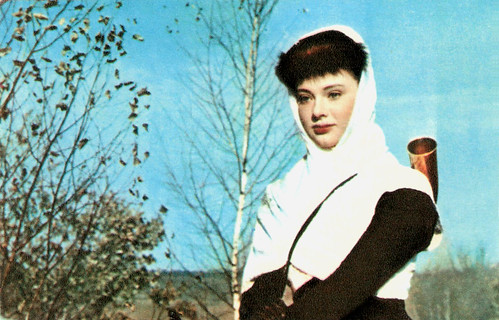
Russian postcard by Izdanije Byuro Propogandy Sovietskogo Kinoiskusstva, no. A 08339, 1969. This postcard was printed in an edition of 500,000 cards. Retail price was 6 kop. Photo: publicity still for Voyna i mir/War and Peace (Sergei Bondarchuk, 1965-1967) with Lyudmila Savelyeva.
The first Soviet picture to win the Oscar
Part I, Andrei Bolkonsky was screened in two consecutive parts, released in a total of 2,805 copies in March 1966. In the fifteen months afterwards, the first sold 58.3 million tickets in the USSR, and 58 million of the viewers remained through the intermission. Thus, Andrei Bolkonsky became the most successful film of the year.
Part II, Natasha Rostova, which opened in July with 1,405 copies disseminated, performed less well and attracted 36.2 million viewers in the same time period, reaching the third place in the 1966 box office, although it would have been ninth if counted in 1967.
The two final parts have deteriorated further: Part III, The Year 1812, with 1,407 copies released, had 21 million admissions and Part IV, Pierre Bezukhov, sold 'merely' 19.8 million tickets. They made it to the 13th and 14th place at the 1967 box office.
With a total of some 135 million tickets sold, Voyna i mir/War and Peace was considered a resounding commercial success at the time.
The series was screened in 117 countries around the world. In East Germany, the state-owned DEFA studio produced a slightly shorter edition of the series, dubbed to German, which ran 409 minutes and maintained the four-part order of the original. Among others, it featured Angelica Domröse, who voiced Lisa Bolkonskaya. It attracted more than 2 million viewers in the German Democratic Republic. In the People's Republic of Poland, it sold over 5 million tickets in 1967, and in France more than 1.2 million tickets
Walter Reade Jr.'s company Continental Distributors purchased the US rights of Voyna i mir/War and Peace for $1.5 million. The distributor shortened the American version by an hour, and added English-language dubbing.
In July 1965, Voyna i mir/War and Peace was awarded the Grand Prix at the 4th Moscow International Film Festival together with the Hungarian entry Húsz óra Twenty Hours (Zoltán Fábri, 1965). In 1967, Voyna i mir was entered into the 1967 Cannes Film Festival, outside of the competition.
In the United States, it won the Golden Globe Award for Best Foreign Language Film in the 26th Golden Globe Awards. The picture was the Soviet entry to the 41st Academy Awards. It received the Academy Award for Best Foreign Language Film and was nominated for the Academy Award for Best Art Direction. Voyna i mir/War and Peace was the first Soviet picture to win the Oscar for best foreign film, and also the longest film ever to receive an Academy Award.
In 1986, Sergei Bondarchuk was requested to prepare Voyna i mir/War and Peace for a broadcast in television. A 35-mm. copy of the series, which was filmed in parallel to the main version and had a 4:3 aspect ratio, rather than the 70-mm. 2.20:1, was submitted, after being adapted by a team headed by Petritsky.
In 1999, as part of an initiative to restore its old classics, Mosfilm resolved to restore Voyna i mir/War and Peace. As the original 70-mm. reels were damaged beyond repair, the studio used the 1988 4:3 version and the original soundtrack to make a DVD edition.
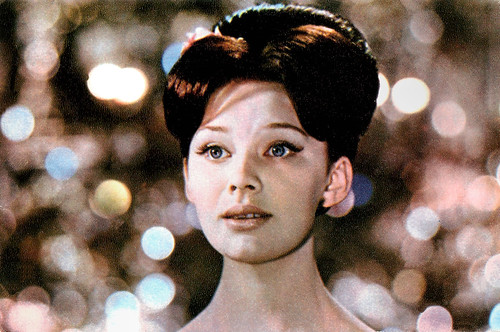
Russian postcard by Izdanije Byuro Propogandy Sovietskogo Kinoiskusstva, no. A 08351, 1969. This postcard was printed in an edition of 500,000 cards. Retail price was 6 kop. Photo: publicity still for Voyna i mir/War and Peace (Sergei Bondarchuk, 1965-1966) with Lyudmila Savelyeva.
Sources: Wikipedia and IMDb.
No comments:
Post a Comment